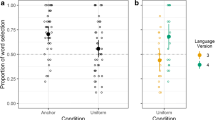Abstract
The subjects' ability to segment foreign speech was examined. Naturalness judgments regarding three syntactically defined pauses [between constituents (noun and verb phrases), words, or syllables] were obtained using a paired-presentation, forced-choice paradigm. It was hypothesized that segmentation skill developed through exposure to lexical and syntactic markers. Teh existence and effect of such markers was investigated by assigning subjects to various exposure conditions.
Results indicated that lexical and syntactic markers exist and can be utilized by subjects in segmenting speech. Contrary to previous research, however, exposure did not facilitate performance. All groups discriminated constituents from either words or syllables, and words from syllables. Results were interpreted as reflecting the interdependence of syntax and suprasegmental phonology. Results challenged the credibility of traditional associationist accounts of language acquisition and speech perception. Results were discussed in the context of Martin's theory of the rhythmic structure of speech.
Similar content being viewed by others
References
Bierwisch, M. (1973). Two critical problems of accent rules.” In Fudge, E. C. (ed.),Phonology, Penguin, London.
Chomsky, N. A., and Halle, M. (1965). Some controversial questions in phonological theory,J. Linguist. 2:97–138.
Chomsky, N. A., and Halle, M. (1968).The Sound Pattern of English, Harper and Row, New York.
Fromkin, V. A. (1971). The non-anomalous nature of anomalous utterances.Language,47:27–52.
Halle, M., and Stevens, K. N. (1964). Speech recognition: A model and a program for research. In Fodor, J. A., and Katz, J. J. (eds.),The Structure of Language: Readings in the Philosophy of Language, Prentice-Hall, Englewood Cliffs, N.J.
Hayes, J. R., and Clark, H. H. (1970). Experiments on segmentation of an artificial speech analogue. In Hayes, J. R. (ed.),Cognition and the Development of Language, Wiley, New York.
Martin, J. G. (1972). Rhythmic (hierarchical) versus serial structure in speech and other behavior.Psychol. Rev. 79:487–509.
Neisser, U. (1967).Cognitive Psychology, Prentice-Hall, Englewood Cliffs, N.J.
Wakefield, J. R., Doughtie, E. B., and Yom, B.-H. L. (1974). The identification of structural components of an unknown language.J. Psycholinguist. Res. 3(3):261–269.
Author information
Authors and Affiliations
Rights and permissions
About this article
Cite this article
Pilon, R. Segmentation of speech in a foreign language. J Psycholinguist Res 10, 113–122 (1981). https://doi.org/10.1007/BF01068032
Accepted:
Issue Date:
DOI: https://doi.org/10.1007/BF01068032




